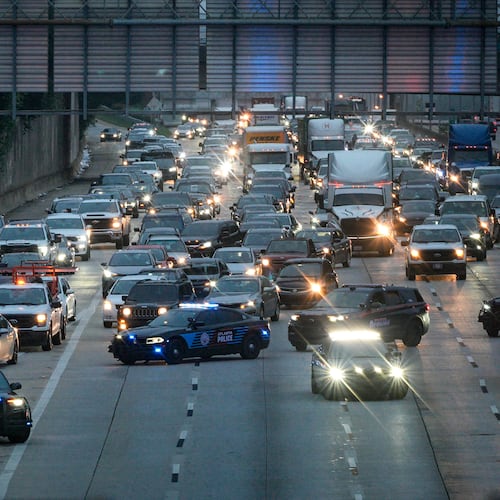Over 4,000 children are hurt each year loading and unloading from school buses and as many as 25,000 kids are injured annually when walking to or from school. Nearly 100 die. And the National Association of State Directors of Pupil Transportation Services reports that an estimated 17 million people illegally passed stopped school buses in 2019. With many schools finally back in session and more students expected to emerge from the pandemic fog in the fall — and with crash and pedestrian fatality numbers rising - the problem has been identified.
Enter Alpharetta’s the iATL (Infrastructure Automobile Technology Laboratory), which has worked with its founding company, Applied Information, and other partners to create various traffic safety solutions since its early-2020 founding. Applied Information has already been instrumental in making parts of North Avenue and Cascade Road “smart corridors,” with traffic lights that talk to cars, buses, and emergency vehicles. And they have done the same in other parts of Metro Atlanta, including Alpharetta.
Last week, the tech incubator unveiled technology affixed to a Fulton County school bus, a nearby school zone speed limit sign, and a 2021 Audi e-tron Sportback that could help curb bad driving behavior.
“This technology is not going to be the be all and end all - but it’s another layer of safety,” explained Peter Ashley, as he drove the Audi both next to the smart school bus with an extended stop arm and in a school zone for nearby Haynes Bridge Middle School.
In a way, the technology is simple. When a school bus driver stops and deploys the stop-arm, the bus sends a signal to nearby vehicles. These smart vehicles have technology integrated into their dashboards that warn drivers in both directions of the stop ahead. As vehicles become more autonomous down the line, these same signals could actually tell cars to stop.
The bus on display last week is the first of its kind and Georgia has been an early adopter of this technology with members of the Fulton County Board of Education and the school system’s transportation department on hand to see it in use. iATL has spent thousands of hours testing this technology on the streets of Alpharetta in what it describes as a 78.5 square mile zone with over 130 connected signals.
They say that Atlanta is a much better testing ground than some other cities, because of its hills, trees, and curvy roads. Applied Information and iATL Bryan Mulligan, who emceed the unveiling, said their rigorous testing on the test bus and trailing car led them to moving the antennae atop the bus to the left side. Why? Because the trees on the side of the road affected the signal.
But for this school safety innovation to take flight, multiple partners both public and private have to buy in. iATL and Applied Information are the technology integrators, but they need the radio and microchip technology from Qualcomm to make their boxes functional. Automakers like Audi have to agree to make their vehicles compatible. Temple has to build the traffic technology to house these signaling devices. Fulton County Schools have to outfit their buses and the City of Alpharetta has to acquiesce to its streets and signals being guinea pigs for the rollout.
Blue Bird, headquartered in Macon, is the nation’s biggest school bus-supplier at around 30-40% market share, so their buy-in for this technology is also a big step. If they agree to eventually outfit all new buses with the proper antennae, then they make it available in many areas.
Connected technology’s benefits to school children extend beyond buses and cars communicating. Smart school zone signs can warn drivers that they are speeding.
“A lot of times you have people traveling around who don’t know they’re speeding in a school zone,” Ashley, a VP at Applied Information, said. “They just don’t know they’re in it.” Ashley explained the smart sign signals the car when it gets within a certain distance and the dashboard warning doesn’t trigger, unless the driver is going more than five mph over the speed limit. We heard the chime and saw the warning at 31 mph in that 25 zone. The warning goes off every seven or eight seconds and stops if the driver properly slows down.
“The whole Chinese market has to have this technology built into [cars]. For next year, every new car has to have this technology in it.” Ashley counted Ford among the manufacturers that are implementing this soon. He also added that he doesn’t expect the U.S. government to mandate these features, but that automakers will on their own because they are safety-related.
The warnings for both the school bus stopping arm and the school zone signs are only slightly interruptive and are meant to nudge drivers into behaving correctly. They both could one day automatically slow driverless cars, but the first step is to get these current models into more school zones and into the newest cars. Of course, people have to start buying these cars for the difference to really show. So it all takes time.
Ashley nearly echoed his boss, McMillan, on the advent and proliferation of their smart traffic devices. “Technology becomes magical at some stage. You don’t realize that the technology is actually running in the background, but what it’s doing is it’s there to save your life or save the lives of school children.”
Doug Turnbull, the PM drive Skycopter anchor for Triple Team Traffic on 95.5 WSB, is the Gridlock Guy. He also hosts a traffic podcast with Smilin’ Mark McKay on wsbradio.com. Contact him at Doug.Turnbull@cmg.com.
About the Author
The Latest
Featured


